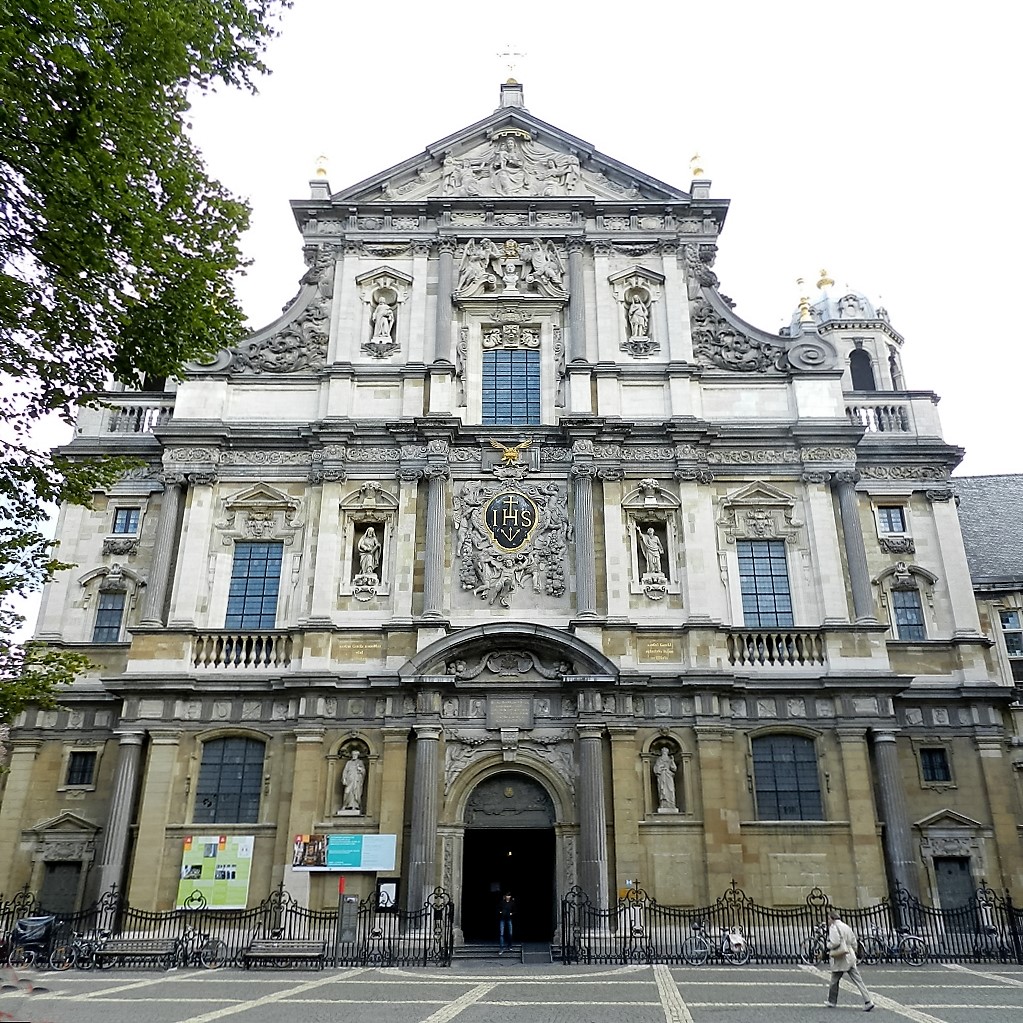The Antwerp jesuit church, a revelation.
The tower
Less to be seen, more to be heard

To start services punctually for believers who do not own a watch yet, churches have been provided with auditive means, bells. They have been here since 1624. To have their sound chimed loudly enough across the roofs into the living rooms, these bronze colossi must be high enough. This bell tower is as tall as 58 m (190 ft.), i.e. the height of six houses. That bronze can also be used for less peaceful purposes, could be experienced by the parishioners in 1943, when the bells Aloysius (403 kg) and Franciscus (588 kg) were requisitioned by the German occupier. Since 1954 there have been four bells again.
The tower is behind the apseSemi-circular or polygonal extension where the high altar is located in a church., which is typically Baroque, and this is the case for several reasons:
- aesthetically: it must not be in the way of the façade
- theologically: it is very close to the high altarThe altar is the central piece of furniture used in the Eucharist. Originally, an altar used to be a sacrificial table. This fits in with the theological view that Jesus sacrificed himself, through his death on the cross, to redeem mankind, as symbolically depicted in the painting “The Adoration of the Lamb” by the Van Eyck brothers. In modern times the altar is often described as “the table of the Lord”. Here the altar refers to the table at which Jesus and his disciples were seated at the institution of the Eucharist during the Last Supper. Just as Jesus and his disciples did then, the priest and the faithful gather around this table with bread and wine., where the EucharistThis is the ritual that is the kernel of Mass, recalling what Jesus did the day before he died on the cross. On the evening of that day, Jesus celebrated the Jewish Passover with his disciples. After the meal, he took bread, broke it and gave it to his disciples, saying, “Take and eat. This is my body.” Then he took the cup of wine, gave it to his disciples and said, “Drink from this. This is my blood.” Then Jesus said, “Do this in remembrance of me.” During the Eucharist, the priest repeats these words while breaking bread [in the form of a host] and holding up the chalice with wine. Through the connection between the broken bread and the “broken” Jesus on the cross, Jesus becomes tangibly present. At the same time, this event reminds us of the mission of every Christian: to be “broken bread” from which others can live. is celebrated and to the tabernacleA small cupboard in the choir or in a specially designated chapel in which the consecrated hosts are kept., where the consecratedIn the Roman Catholic Church, the moment when, during the Eucharist, the bread and wine are transformed into the body and blood of Jesus, the so-called transubstantiation, by the pronouncement of the sacramental words. hosts are kept. They make Jesus’ presence tangible and are therefore called ‘Holy Sacrament’. This explains why since the 19th century there has been a group of statues of angels on the facade in St.-Kathelijnevest, who kneel in worship of the chaliceGilded metal cup, usually on a base, which the priest uses for the wine during the Eucharist. and a hostA portion of bread made of unleavened wheat flour that, according to Roman Catholic belief, becomes the body of Christ during the Eucharist..
As the tower is behind the church and an impressive screen, which is the facade, hides it from our view, this pearl of Baroque architecture is hardly visible from the church square. The elegant design deserves our attention though.
How elegant is the solution to climb up from a square base to one point at the tower’s cross? The big lantern has a smaller lantern as a crowning, which also functions as a base for the cross.
How graceful is the fourfold use of the Venetian opening, or Serlian arch, in the big lantern? This motif consists of three openings between four pillars: the central one is covered by a rounded arch, the two side openings by a horizontal architrave. This Serlian arch, named after architect Serlio (1475-1554), is a contribution of Rubens, who, during his stay at the ducal palace in Mantua, could look up at a church tower with this motif every day.
A signpost ‘Beware! Falling stones!’ could have been useful now and then. On 7th April 1906, a falling bluestone caused the death of a paperer from Koepoortbrug. In the beginning of the 1990’s rubble fell onto a car. This was not to be wondered since a real tree was growing on the tower. Since then till the end of the restoration in 2006 the tower was in scaffolding. ‘The mills of God grind slowly, yet they grind exceeding small’ apparently also goes for the mills of administration.

- Saint Charles Borromeo’s Church
- History & Description
- Introduction
- The historic context
- Square and residence
- Previous history
- The college
- Spatial effects
- Names of streets
- Profess house
- Sodality building
- Façade
- Tower
- Interior
- High altar
- Pulpit
- Confessionals
- Ceiling paintings
- Our Lady’s chapel
- Saint Ignatius chapel
- Chapel of Saint Francis Xavier
- Galleries
- Organ
- Sacristy
- When leaving
- Epilogue
- Bibliography

